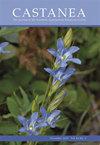谢南多厄河州立公园沃伦公司,弗吉尼亚州的植物清单
IF 0.3
4区 生物学
Q4 PLANT SCIENCES
引用次数: 0
摘要
在2021年和2022年的生长季节,对弗吉尼亚州本顿维尔的谢南多阿河州立公园(SHSP)的维管植物区系进行了检查。SHSP占地665公顷(1619英亩),位于马萨努滕山脉和谢南多厄国家公园之间的谢南多厄山谷北部。该公园位于沃伦县,在植物学上一直未得到充分开发,在谢南多厄山谷北部五个县的植物收集指标中一直排名最后。SHSP包含11种群落类型,跨越海拔165-296米,从内陆湿地和河流冲刷群落到高地森林,包括特有的阿巴拉契亚中部页岩贫瘠地。共收集797个标本,鉴定出109个维管植物科的536个独特分类群。这些收藏在iNaturalist项目页面上汇总了实地照片,并进行了二次扩展。我们使用快速响应码将植物标本馆券与各自的innaturalist条目链接起来。记录了沃伦县尚未观察到的64个县的分类群记录和一个州的分类群记录,laevigatum。作为SHSP的第一个项目,该植物区系清单提供了公园的基本植物学知识,并将沃伦县维管植物的可用数字数据扩展了20%。这些增加的知识,连同附带的iNaturalist项目页面,不仅对公园管理者未来的发展和保护计划有用,而且还将成为社区科学家提高他们对当地植物群知识的工具。本文章由计算机程序翻译,如有差异,请以英文原文为准。
A Floristic Checklist of Shenandoah River State Park Warren Co., Virginia
ABSTRACT A floristic checklist of vascular plants was conducted at Shenandoah River State Park (SHSP) in Bentonville, Virginia during the 2021 and 2022 growing seasons. SHSP encompasses 665 hectares (1619 acres) of the northern Shenandoah Valley between the Massanutten Mountains and Shenandoah National Park. The park lies in Warren County which has been botanically underexplored, consistently ranking last in plant collection metrics among the five northern Shenandoah Valley counties. SHSP contains 11 community types that span 165–296 meters above sea level from inland wetlands and river scour communities to upland forests, including endemic Central Appalachian Shale Barrens. A total of 797 collections yielded 536 unique taxa from 109 vascular plant families. These collections were secondarily extended with in-field pictures that were aggregated on an iNaturalist project page. Quick Response (QR) codes were used to link herbarium vouchers to their respective iNaturalist entry. Sixty-four county records of taxa not yet observed in Warren County and one state record, Equisetum laevigatum, were documented. As a first for SHSP, this floristic checklist provides baseline botanical knowledge of the park and expands the available digital data of vascular plants for Warren County by 20%. This augmented knowledge, in tandem with the accompanying iNaturalist project page, will not only be useful to park managers for future development and conservation plans but will also serve as a tool for community scientists to enhance their knowledge of the local flora.
求助全文
通过发布文献求助,成功后即可免费获取论文全文。
去求助
来源期刊

Castanea
生物-植物科学
CiteScore
0.50
自引率
25.00%
发文量
28
审稿时长
>12 weeks
期刊介绍:
Castanea is named in honor of the American Chestnut tree. Castanea is thebotanical name for Chestnuts, dating back to what the ancient Greeks calledthem.
The American Chestnut is a critically endangered tree that once made up 35%of the forests of the Eastern US before being devastated by a blight thatdestroyed up to 4 billion American Chestnut trees.
Castanea serves professional and amateur botanists by reviewing andpublishing scientific papers related to botany in the Eastern United States.
We accept papers relating to plant biology, biochemistry, ecology, floristics,physiology and systematics.
 求助内容:
求助内容: 应助结果提醒方式:
应助结果提醒方式:


